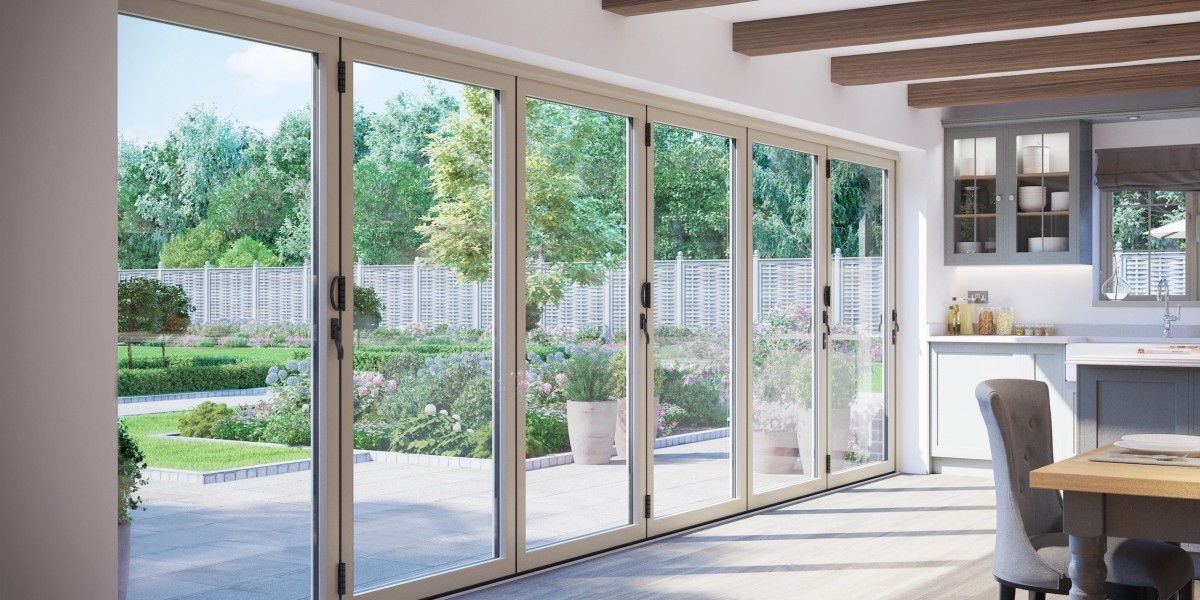Unfolding Solutions: A Guide to Bifold Door Repairs
Bifold doors, with their concertina-like design, use a great mix of space-saving performance and aesthetic appeal. Whether beautifying a closet, dividing rooms, or opening up patio areas to the outdoors, these doors bring a special touch to any space. Their capability to neatly fold away, making the most of access and light, makes them a popular option in contemporary homes and business settings alike. Nevertheless, like any moving element within a building, bifold doors are susceptible to use and tear with time. From minor hassles like sticking or squeaking to more substantial issues like drooping or damaged panels, problems can emerge that disrupt their smooth operation and diminish their intended function.

Comprehending common bifold door issues and understanding how to resolve them is vital for keeping their performance and durability. This short article intends to be your detailed guide to bifold door repairs. We'll explore the typical offenders behind bifold door breakdowns, explore DIY repair possibilities, and talk about when it's finest to call in the specialists. By arming yourself with this knowledge, you can ensure your bifold doors continue to run perfectly and boost your living or workplace for many years to come.
Common Bifold Door Problems: Identifying the Issues
Before you can embark on any repairs, it's necessary to accurately diagnose the issue affecting your bifold doors. Recognizing the symptoms and understanding their possible causes will improve the repair process and avoid unneeded work. Here are a few of the most frequently encountered issues with bifold doors:
Difficulty Opening or Closing: This is possibly the most common grievance. The door may feel stiff, resist motion, or get stuck at certain points along its track. This can frequently originate from numerous elements, consisting of:
- Dirty or Obstructed Tracks: Dust, debris, and even small objects can build up in the tracks, preventing the smooth glide of the rollers.
- Dry or Damaged Rollers: Rollers are crucial for the simple and easy movement of bifold door won't stay closed doors. Absence of lubrication, wear and tear, or damage can trigger them to stick or grind.
- Misalignment: If the door panels or track are misaligned, the doors may bind and struggle to open or close effectively.
- Blockages within the Doorway: Sometimes, the problem isn't with the door itself however with something obstructing its course, like a rug that has shifted or products placed too near the opening.
Sagging Doors: Over time, bifold doors can start to sag, making them tough to run and possibly causing them to scrape along the floor or frame. This sagging is typically attributable to:
- Loose Hinges: Hinges are vital for supporting the weight of the door panels. Loose hinges can cause sagging and misalignment.
- Insufficient Support: If the door frame or track isn't offering adequate support, the weight of the doors can trigger them to droop.
- Door Weight: In some cases, the doors themselves might be too heavy for the hardware, especially if they are strong core or made from heavier products.
Harmed Panels: Bifold door panels, especially those made of thinner materials like hollow-core wood or MDF, can be susceptible to damage:
- Cracks and Dents: Impacts or unexpected force can lead to fractures or dents in the panels.
- Water Damage: In locations susceptible to moisture, or in bathrooms, panels can warp or swell due to water ingress.
- Surface Damage: Scratches, chips, or peeling veneer can detract from the door's look.
Hardware Issues: The different hardware parts of bifold doors are vital for their function. Issues with these can result in functional troubles:
- Loose or Broken Hinges: As discussed, loose hinges contribute to drooping, and broken hinges can render the door unusable.
- Faulty Handles or Latches: Broken manages or locks can make it hard to open, close, or secure the doors.
- Harmed Pivot Points: The pivot points where the doors fold are crucial for smooth motion. Damage or wear here can trigger stiffness and sticking.
Track Problems: The track is the structure upon which the bifold doors operate. Problems here will straight affect door function:
- Bent or Damaged Track: Accidental impacts or settling of the building can flex or damage the track, hindering roller motion.
- Misaligned Track: If the track is not properly set up or has actually shifted, the doors will not run smoothly.
Spaces and Draughts: Bifold doors are developed to close relatively comfortably. Gaps or draughts suggest an issue:
- Misalignment: Misaligned panels may not meet effectively, creating gaps.
- Used Weather Stripping: Weather removing around the door perimeter assists seal spaces. If damaged or worn, it will fail to provide an appropriate seal, resulting in draughts and possibly increased sound.
Sound Issues: Bifold doors ought to run relatively silently. Squeaking, grinding, or rattling sounds suggest friction or loose components:
- Dry Rollers or Hinges: Lack of lubrication in rollers or hinges typically results in squeaking or grinding sounds.
- Loose Hardware: Loose screws or other hardware can cause rattling sounds when the doors are moved.
DIY vs. Professional Repair: Choosing the Right Approach
Once you've diagnosed the problem, the next step is to decide whether you can tackle the repair yourself or if it's finest to contact an expert. The choice often depends on a number of elements:
DIY Repairs - Pros and Cons:
Pros:
- Cost-Effective: DIY repairs can save you money on labor expenses, often requiring just the expense of replacement parts or standard tools you might already own.
- Benefit: You can frequently attend to minor repairs at your own rate and schedule, without awaiting a contractor visit.
- Learning Experience: DIY repairs can be an important knowing experience and provide you a higher understanding of how your bifold doors work.
Cons:
- Time Commitment: DIY repairs can be time-consuming, especially if you are not familiar with the process.
- Prospective for Mistakes: Incorrect repairs can get worse the problem and even damage the doors further, potentially resulting in more pricey expert intervention later.
- Tool Requirements: Certain repairs may require customized tools that you may not have.
- Safety Concerns: Repairs including ladders, heavy doors, or power tools can position security risks if not handled correctly.
Professional Repairs - Pros and Cons:
Pros:

- Expertise and Experience: Professionals have the understanding and experience to accurately diagnose and efficiently repair a vast array of bifold door issues.
- Performance: Professionals can typically complete repairs quickly and efficiently, decreasing disturbance.
- Assurances and Warranties: Reputable experts often offer assurances or service warranties on their work, providing comfort.
- Specialized Tools and Parts: Professionals have actually access to specialized tools and a larger series of replacement parts if required.
Cons:
- Higher Cost: Professional repairs will inevitably be more costly due to labor expenses and potential call-out fees.
- Arranging Inconvenience: You might require to schedule a consultation and wait on an expert to appear.
When to DIY vs. When to Call a Pro:
DIY Suitable For:
- Simple tasks like cleaning tracks and rollers.
- Oiling hinges and rollers.
- Tightening up loose screws.
- Replacing easily available and basic hardware components (rollers, manages).
- Minor cosmetic repairs like touching up paint or filling little damages.
Specialist Recommended For:
- Complex problems like door or track misalignment that need accurate adjustments.
- Drooping door concerns that may involve structural assistance or hinge replacements.
- Replacement of whole panels or doors, especially if they are bespoke or need exact fitting.
- Repairs involving damage to the frame or structural components.
- Any repair that feels beyond your ability level or convenience zone, particularly those involving security concerns.
Step-by-Step Repair Guides for Common Issues
While some repairs need expert proficiency, lots of typical bifold door problems can be attended to with a little DIY know-how. Here are step-by-step guides for dealing with some of the most frequent concerns:
1. Resolving Sticking or Difficult Opening/Closing:
* ** Step 1: Inspect and Clean the Tracks. **.* Use a vacuum cleaner with a crevice tool or a brush to completely clean up the leading and bottom tracks of any dust, debris, or obstructions.* ** Step 2: Lubricate Rollers and Tracks. **.* Apply a silicone-based lube to the rollers and along the tracks. Prevent oil-based lubricants, as they can bring in dust.* Operate the doors numerous times to disperse the lubricant evenly.* ** Step 3: Inspect Rollers for Damage. **.* Visually inspect each roller for fractures, chips, or extreme wear.* If rollers are harmed, they will need to be replaced (see hardware replacement section listed below).* ** Step 4: Check for Obstructions. **.* Ensure absolutely nothing is physically obstructing the door's course, inside or outside the entrance.2. Replacing Worn or Damaged Rollers:
* ** Step 1: Identify Roller Type and Size. **.* Carefully get rid of a sample roller to figure out the type (e.g., top-hung, bottom-roller) and its measurements.* ** Step 2: Purchase Replacement Rollers. **.* Visit a hardware store or online supplier to buy matching replacement rollers.* ** Step 3: Remove Old Rollers. **.* Depending on the style, you might require to unscrew or unclip the old rollers. Refer to your door's installation guidelines if readily available.* ** Step 4: Install New Rollers. **.* Carefully insert and protect the brand-new rollers in location, ensuring they are correctly lined up and move freely.* ** Step 5: Test Door Operation. **.* Gently run the doors to examine if the brand-new rollers have actually fixed the sticking problem. Lube as needed.3. Tightening Up Loose Hinges:
* ** Step 1: Identify Loose Hinges. **.* Visually check all hinges linking the door panels for looseness or movement.* ** Step 2: Tighten Screws. **.* Use a screwdriver of the proper size to carefully tighten up any loose screws on the hinges.* Avoid over-tightening, which can strip the screw holes.* ** Step 3: Consider Longer Screws (if required). **.* If screws continually loosen, it may be required to replace them with slightly longer screws to get a much better grip in the door frame or panel.* ** Step 4: Test Door Operation. **.* Check if tightening up the hinges has actually improved door alignment and lowered drooping.Preventive Maintenance: Keeping Your Bifold Doors in Top Shape
Routine maintenance is crucial to preventing lots of bifold door problems and extending their life-span. Incorporating these basic upkeep practices can save you time and cash in the long run:
- Regular Cleaning: Clean the tracks and door panels frequently (at least monthly, or more regularly in dusty environments) to prevent particles accumulation.
- Lubrication: Lubricate rollers and hinges with silicone lubricant every few months to guarantee smooth and peaceful operation.
- Hardware Checks: Periodically examine all screws and hardware elements for tightness and tighten as required.
- Visual Inspections: Regularly examine doors for signs of damage, wear, or misalignment. Address minor concerns without delay before they intensify.
- Mild Operation: Avoid slamming or requiring the doors, as this can harm hardware and cause misalignment.
Cost Considerations for Bifold Door Repair
The cost of bifold door repair can vary widely depending upon the nature of the problem, whether you DIY or employ an expert, and the expense of parts.
DIY Repair Costs:
- Primarily product costs, including:
- Replacement rollers, hinges, handles: Prices range from a couple of dollars for private parts to sets costing ₤ 20- ₤ 50 or more.
- Lube, cleaning up supplies: Relatively economical.
- Tools (if you require to purchase any): Basic screwdrivers are economical; specialized tools may contribute to the expense.
Expert Repair Costs:
- Include labor costs in addition to parts.
- Hourly rates for handymen or door repair experts can vary from ₤ 50 to ₤ 100 or more, depending on place and intricacy.
- Call-out charges may apply.
- More intricate repairs (e.g., panel replacement, considerable realignment) will naturally be more pricey.
Aspects Influencing Repair Costs:
- Complexity of the Problem: Simple fixes like cleansing and lubrication will be the least pricey. Significant repairs or replacements will be more expensive.
- DIY vs. Professional: DIY is usually cheaper for fundamental repairs.
- Parts and Materials: The expense of replacement parts will vary depending on the type and quality.
- Location: Labor costs can fluctuate based on your geographical place.
- Emergency Repairs: Emergency or after-hours repairs might sustain surcharges.
weatherproof bifold door repairs doors are a valuable possession to any residential or commercial property, providing performance and design. By understanding typical issues, understanding when to DIY and when to seek professional help, and practicing routine upkeep, you can keep your bifold doors operating smoothly and looking their best for several years to come. Dealing with minor problems immediately is always better than disregarding them until they become major, more pricey headaches. Make the effort to understand your bifold doors, and they will continue to unfold benefit and charm in your space.
Frequently Asked Questions: Bifold Door Repair
Q: How do I know if I can DIY a bifold door repair or if I need to call a professional?
A: Start by assessing the problem. If it's a basic issue like sticking doors that might be solved with cleansing and lubrication, or changing a visible and quickly available roller or manage, DIY may be appropriate. If the problem is structural, includes misalignment, panel replacement, or anything that feels beyond your ability level, it's absolutely best to call a professional. Consider your comfort level with DIY tasks and prioritize safety.
Q: How much does bifold door repair normally cost?
A: DIY repairs can cost just a few dollars for lubricant or replacement rollers. Professional repairs can vary from ₤ 50 to several hundred dollars depending on the complexity of the issue, labor rates, and parts required. Get quotes from numerous experts for bigger repairs to compare expenses.
Q: What tools are typically needed for basic bifold door repairs?
A: For a lot of standard repairs, you'll require:
- Screwdrivers (Phillips and flathead in different sizes)
- Vacuum cleaner with crevice tool
- Brush or tooth brush (for cleaning tracks)
- Silicone-based lube
- Possibly pliers or wrenches, depending on hardware.
- Shatterproof glass and gloves are constantly recommended.
Q: How often should I lubricate my bifold doors?
A: It's normally suggested to oil rollers and hinges every 3-6 months, or more regularly if you see any squeaking, sticking, or tightness in operation.
Q: Can I replace a bifold door panel myself?
A: Replacing a single bifold door panel can be complex, especially if it needs exact matching of size, style, and hardware. It might be DIY-able if you are comfy with woodworking and have the needed tools and skills. However, it's frequently recommended to seek professional help for panel replacements, especially if the doors are custom-made or need precise fitting within the track system. Professionals can likewise ensure correct alignment and prevent more problems after panel replacement.







